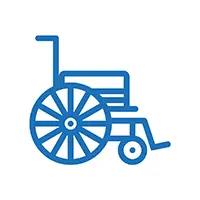Published 15 March 2023

Rory going against a runner in his new OctalWheels manual wheelchair
“Cars went from a Model T Ford to a Tesla in a hundred years, but wheelchairs did not change. We thought, perhaps this was not the best of all possible worlds.”
Rory and Claire Flemmer are the engineers behind the new manual wheelchair, OctalWheels. The academic couple started on their quest more than thirty years ago. They were at the University of New Mexico when they saw an elderly woman in a wheelchair who was trapped on a ramp. She was not strong enough to go up and was too frightened to go down.
They supported her on the ramp but were surprised and indignant that the world had not made a better wheelchair.
“Looking back, I am amazed at our cheek. The two of us were going to make the world’s best wheelchair,” says Rory “I mean, really! I am still a bit embarrassed for us.” But they stuck to it for 37 years. Rory is now aged 75 with a new OctalWheels chair that can keep up with a jogger.
Rory is a chemical and mechanical engineer and Claire is a mechanical and aerospace engineer from South Africa. The pair have PhDs and call Palmerston North home. Claire is a senior lecturer at Massey University while Rory has retired from lecturing.
The Flemmers are understandably proud of their OctalWheels wheelchair, which is now on sale. It has three gears, brakes, and anti-rollback, and goes as fast as a runner (13 kph). Most importantly, it doesn’t hurt people’s shoulders.
Rory and Claire found wheelchair users hurt their arms and shoulders and do not get enough exercise. They cannot get exercise in their wheelchairs without damaging their shoulders.
When the OctalWheels handles are folded away, it’s a normal wheelchair that can be driven indoors with push rims. When the handles are pulled out, it becomes more like a bicycle than a wheelchair.
“Our design means you get exercise, which a powered wheelchair just does not give you,” says Rory. “Another innovation we focused on was the cross-slope.”
A cross-slope is an uneven pathway that puts wheelchair users in danger of tipping over, forcing them to push one wheel harder than the other.
“OctalWheels lets you go outdoors without the curse of the cross-slope, you can just turn it off with a little handle,” says Rory.
At the moment, the Flemmers sell a complete wheelchair, ready to roll. They suggest it’s best to have an indoor wheelchair and an exercise wheelchair at the front door, just waiting to go.
Check out the performance tests and a whole lot more info on their website.
Visit OctalWheels.com to find more information about Rory and Claire’s wheelchairs. (external link)
“Our main finding is that it is fun to use the OctalWheels wheelchair. You go fast, easily. It is cool and it is so good for you – a new way of life.”
The other unusual result from performance tests is that where a standard wheelchair can travel around a 1.1 km block in about 18 minutes, . Octawheels can do it in just over six minutes.
The OctalWheels wheelchair is being marketed worldwide, with pride. “New Zealand punching above its weight – again,” say Rory and Claire.
Soon they will offer standalone cross-slope control kits, without the new OctalWheels, which fit them into a standard wheelchair. The team are also working on a paediatric wheelchair and a sports wheelchair that will go 20kph.
“But that is down the road a little,” says Rory.














